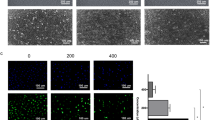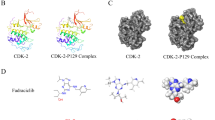Abstract
Glioblastoma is a lethal malignant brain tumor, and the development of efficient chemotherapeutic agents remains an urgent need. Niclosamide, an anthelmintic drug, which has been used to treat tapeworm infections more than 50 years, has recently attracted renewed attention due to its evident anticancer activities. It has been shown that niclosamide induces cytotoxicity in human glioblastoma U-87 MG cells corresponding with increased protein ubiquitination, ER stress, and autophagy. Furthermore, niclosamide showed down regulation of multiple pro-survival signaling pathways including Wnt/β-catenin, PI3K/AKT, MAPK/ERK, and STAT3, which further caused reduction of U87-MG cell viability. However, the molecular mechanisms of niclosimide and its derivatives in cancer are not fully understood. In the present article, 12 niclosamide derivatives were synthesized by the replacement of substituents for the structure-activity relationship (SAR) study of the protein ubiquitination and related signaling pathways. Our approach is to identify which substituents of niclosamide play important roles in inducing cell apoptosis, inhibition of cell growth, and down regulation of cell survival signaling pathways. Our results indicate that phenol OH of niclosamide plays a significant role in the anti-glioblastoma activity, while missing Cl (5- or 2′-Cl) showed almost no such effect. 4′-N3 or CF3 has the similar activity to niclosamide (4′-NO2) whereas NH2 significantly decreased the cytotoxicity in U87 cells. These modified compounds can be tested to determine which are most effective on cancer treatment. These findings are important in the development of multi-functionalized niclosamide and drug design therapy in the future.

Graphical abstract




Similar content being viewed by others
References
Mercer RW, Tyler MA, Ulasov IV, Lesniak MS. Targeted therapies for malignant glioma. BioDrugs. 2009;23:25–35. https://doi.org/10.2165/00063030-200923010-00003.
Shangguan F, Liu Y, Ma L, Qu G, Lv Q, An J. et al. Niclosamide inhibits ovarian carcinoma growth by interrupting cellular bioenergetics. J Cancer. 2020;11:3454–66. https://doi.org/10.7150/jca.41418.
Lee Y, Lee JK, Ahn SH, Lee J, Nam DH. WNT signaling in glioblastoma and therapeutic opportunities. Lab Invest. 2016;96:137–50. https://doi.org/10.1038/labinvest.2015.140.
Mukthavaram R, Ouyang X, Saklecha R, Jiang P, Nomura N, Pingle SC. Effect of the JAK2/STAT3 inhibitor SAR317461 on human glioblastoma tumorspheres. J Transl Med. 2015;13:269. https://doi.org/10.1186/s12967-015-0627-5.
Solinas M, Massi P, Cinquina V, Valenti M, Bolognini D, Gariboldi M. et al. Cannabidiol, a non-psychoactive cannabinoid compound, inhibits proliferation and invasion in U87-MG and T98G glioma cells through a multitarget effect. PLoS One. 2013;8:e76918. https://doi.org/10.1371/journal.pone.0076918.
Luwor RB, Stylli SS, Kaye AH. The role of Stat3 in glioblastoma multiforme. J Clin Neurosci. 2013;20:907–11. https://doi.org/10.1016/j.jocn.2013.03.006.
Taylor TE, Furnari FB, Cavenee WK. Targeting EGFR for treatment of glioblastoma: molecular basis to overcome resistance. Curr Cancer Drug Targets. 2012;12:197–209. https://doi.org/10.2174/156800912799277557.
Sathornsumetee S. Therapeutic strategies to target multiple kinases in glioblastoma. Anticancer Agents Med Chem. 2011;11:700–11. https://doi.org/10.2174/187152011797378661.
Sunayama J, Matsuda K, Sato A, Tachibana K, Suzuki K, Narita Y. et al. Crosstalk between the PI3K/mTOR and MEK/ERK pathways involved in the maintenance of self-renewal and tumorigenicity of glioblastoma stem-like cells. Stem Cells. 2010;28:1930–9. https://doi.org/10.1002/stem.521.
Geng Y, Kohli L, Klocke BJ, Roth KA. Chloroquine-induced autophagic vacuole accumulation and cell death in glioma cells is p53 independent. Neuro Oncol. 2010;12:473–81. https://doi.org/10.1093/neuonc/nop048.
Weinbach EC, Garbus J. Mechanism of action of reagents that uncouple oxidative phosphorylation. Nature. 1969;221:1016–8. https://doi.org/10.1038/2211016a0.
Kaushal JB, Bhatia R, Kanchan RK, Raut P, Mallapragada S, Ly QP, et al. Repurposing niclosamide for targeting pancreatic cancer by inhibiting Hh/Gli non-canonical axis of Gsk3β. Cancers. 2021;13:3105.
Luo F, Luo M, Rong Q-X, Zhang H, Chen Z, Wang F. et al. Niclosamide, an antihelmintic drug, enhances efficacy of PD-1/PD-L1 immune checkpoint blockade in non-small cell lung cancer. J Immunother Cancer. 2019;7:245. https://doi.org/10.1186/s40425-019-0733-7.
Kadri H, Lambourne OA, Mehellou Y. Niclosamide, a drug with many (Re)purposes. ChemMedChem. 2018;13:1088–91. https://doi.org/10.1002/cmdc.201800100.
Kumar R, Coronel L, Somalanka B, Raju A, Aning OA, An O. et al. Mitochondrial uncoupling reveals a novel therapeutic opportunity for p53-defective cancers. Nat Commun. 2018;9:3931. https://doi.org/10.1038/s41467-018-05805-1.
Burock S, Daum S, Keilholz U, Neumann K, Walther W, Stein U. Phase II trial to investigate the safety and efficacy of orally applied niclosamide in patients with metachronous or sychronous metastases of a colorectal cancer progressing after therapy: the NIKOLO trial. BMC Cancer. 2018;18:297. https://doi.org/10.1186/s12885-018-4197-9.
Alasadi A, Chen M, Swapna GVT, Tao H, Guo J, Collantes J. et al. Effect of mitochondrial uncouplers niclosamide ethanolamine (NEN) and oxyclozanide on hepatic metastasis of colon cancer. Cell Death Dis. 2018;9:215. https://doi.org/10.1038/s41419-017-0092-6.
Li Y, Li P-K, Roberts MJ, Arend RC, Samant RS, Buchsbaum DJ. Multi-targeted therapy of cancer by niclosamide: A new application for an old drug. Cancer Lett. 2014;349:8–14. https://doi.org/10.1016/j.canlet.2014.04.003.
Barbosa EJ, Löbenberg R, de Araujo GLB, Bou-Chacra NA. Niclosamide repositioning for treating cancer: Challenges and nano-based drug delivery opportunities. Eur J Pharmaceutics Biopharmaceutics. 2019;141:58–69. https://doi.org/10.1016/j.ejpb.2019.05.004.
Chen W, Mook RA Jr., Premont RT, Wang J. Niclosamide: Beyond an antihelminthic drug. Cell Signal. 2018;41:89–96. https://doi.org/10.1016/j.cellsig.2017.04.001.
Wieland A, Trageser D, Gogolok S, Reinartz R, Höfer H, Keller M, et al. Anticancer effects of niclosamide in human glioblastoma. Clin Cancer Res. 2013;19:4124–36. https://doi.org/10.1158/1078-0432.Ccr-12-2895.
Cheng B, Morales LD, Zhang Y, Mito S, Tsin A. Niclosamide induces protein ubiquitination and inhibits multiple pro-survival signaling pathways in the human glioblastoma U-87 MG cell line. PLoS One. 2017;12:e0184324. https://doi.org/10.1371/journal.pone.0184324.
Bermea KC, Casillas EA, Morales LD, Valdez LL, Su BB, Tsin A, et al. Evidence of a neuroprotective function for niclosamide in human SH-SY5Y neuroblastoma and rat PC12 neural cells acta scientific. Neurology. 2020;3:85–94.
Mook RA Jr., Wang J, Ren XR, Chen M, Spasojevic I, Barak LS. et al. Structure-activity studies of Wnt/β-catenin inhibition in the Niclosamide chemotype: Identification of derivatives with improved drug exposure. Bioorg Med Chem. 2015;23:5829–38. https://doi.org/10.1016/j.bmc.2015.07.001.
Mook RA Jr., Chen M, Lu J, Barak LS, Lyerly HK, Chen W. Small molecule modulators of Wnt/β-catenin signaling. Bioorg Med Chem Lett. 2013;23:2187–91. https://doi.org/10.1016/j.bmcl.2013.01.101.
Carbone G, Burnley J, Moses JE. A catalytic and tert-butoxide ion-mediated amidation of aldehydes with para-nitro azides. Chem Commun. 2013;49:2759–61. https://doi.org/10.1039/C3CC40452H.
Xia C, Xu J, Wu W, Liang X. Pd/C-catalyzed hydrodehalogenation of aromatic halides in aqueous solutions at room temperature under normal pressure. Catal Commun. 2004;5:383–6. https://doi.org/10.1016/j.catcom.2004.04.006.
Marzi E, Gorecka J, Schlosser M. The regioexhaustive functionalization of difluorophenols and trifluorophenols through organometallic intermediates. Synthesis. 2004;2004:1609–18.
Fonseca BD, Diering GH, Bidinosti MA, Dalal K, Alain T, Balgi AD. et al. Structure-activity analysis of niclosamide reveals potential role for cytoplasmic pH in control of mammalian target of rapamycin complex 1 (mTORC1) signaling. J Biol Chem. 2012;287:17530–45. https://doi.org/10.1074/jbc.M112.359638.
Chen X, Cubillos-Ruiz JR. Endoplasmic reticulum stress signals in the tumour and its microenvironment. Nat Rev Cancer. 2021;21:71–88. https://doi.org/10.1038/s41568-020-00312-2.
Ding W-X, Ni H-M, Gao W, Yoshimori T, Stolz DB, Ron D, et al. Linking of autophagy to ubiquitin-proteasome system is important for the regulation of endoplasmic reticulum stress and cell viability. Am J Pathol. 2007;171:513–24. https://doi.org/10.2353/ajpath.2007.070188.
Xu J, Berastegui-Cabrera J, Ye N, Carretero-Ledesma M, Pachón-Díaz J, Chen H, et al. Discovery of novel substituted N-(4-Amino-2-chlorophenyl)-5-chloro-2-hydroxybenzamide analogues as potent human adenovirus inhibitors. J Medicinal Chem. 2020;63:12830–52. https://doi.org/10.1021/acs.jmedchem.0c01226.
Perin N, Roškarić P, Sović I, Boček I, Starčević K, Hranjec M, et al. Amino-substituted benzamide derivatives as promising antioxidant agents: a combined experimental and computational study. Chem Res Toxicol. 2018;31:974–84. https://doi.org/10.1021/acs.chemrestox.8b00175.
He X, Li M, Ye W, Zhou W. Discovery of degradable niclosamide derivatives able to specially inhibit small cell lung cancer (SCLC). Bioorg Chem. 2021;107:104574. https://doi.org/10.1016/j.bioorg.2020.104574.
Fomovska A, Wood RD, Mui E, Dubey JP, Ferreira LR, Hickman MR, et al. Salicylanilide inhibitors of toxoplasma gondii. J Medicinal Chem. 2012;55:8375–91. https://doi.org/10.1021/jm3007596.
Acknowledgements
The chemistry part in this manuscript is supported by College of Science SEED grant at The University of Texas Rio Grande Valley (UTRGV), and Welch Foundation departmental Grant (BX-0048). SM acknowledge the support of COS Writing-mentoring program. Valerie Tobias is also acknowledged for checking the references. Also, this work is supported by the Department of Molecular Science, School of Medicine at UTRGV and funding from the State of Texas Innovative Research and Development Program. The authors also appreciate Drs. J. G. Persons and J. Gutierrez for proofreading this manuscript.
Author information
Authors and Affiliations
Contributions
SM and BC conceptualized the study and supervised and provided support throughout the project. SM designed the modifications and interpreted the data. SM, BAG and TCR synthesized and characterized the compounds. BC, DG, XYO and FXE conducted the cell culture and Western blot analysis. AZ provided the support for biological assays. SC and MAA conducted MTT assays. The manuscript was written through contributions of all authors. All authors have given approval to the final version of the manuscript.
Corresponding author
Ethics declarations
Conflict of interest
The authors declare no competing interests.
Additional information
Publisher’s note Springer Nature remains neutral with regard to jurisdictional claims in published maps and institutional affiliations.
Supplementary Information
Rights and permissions
About this article
Cite this article
Mito, S., Cheng, B., Garcia, B.A. et al. SAR study of niclosamide derivatives in the human glioblastoma U-87 MG cells. Med Chem Res 31, 1313–1322 (2022). https://doi.org/10.1007/s00044-022-02907-w
Received:
Accepted:
Published:
Issue Date:
DOI: https://doi.org/10.1007/s00044-022-02907-w




